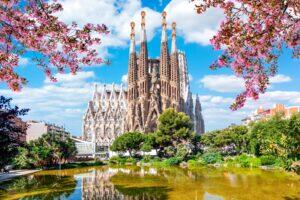Fodor's Expert Review Basílica de Santa Maria del Pi
Sister church to Santa Maria del Mar and to Santa Maria de Pedralbes, this early Catalan Gothic structure is perhaps the most fortresslike of all three: hulking, dark, and massive, and perforated only by the main entryway and the mammoth rose window, said to be the world's largest. Try to see the window from inside in the late afternoon to get the best view of the colors. The church was named for the lone pi (pine tree) that stood in what was a marshy lowland outside the 4th-century Roman walls. An early church dating back to the 10th century preceded the present Santa Maria del Pi, which was begun in 1319 and finally consecrated in 1453. The interior compares poorly with the clean and lofty lightness of Santa Maria del Mar, but there are two interesting things to see: the original wooden choir loft, and the Ramón Amadeu painting La Mare de Deu dels Desamparats (Our Lady of the Helpless), in which the artist reportedly used his wife and children as models for the... READ MORE
Sister church to Santa Maria del Mar and to Santa Maria de Pedralbes, this early Catalan Gothic structure is perhaps the most fortresslike of all three: hulking, dark, and massive, and perforated only by the main entryway and the mammoth rose window, said to be the world's largest. Try to see the window from inside in the late afternoon to get the best view of the colors. The church was named for the lone pi (pine tree) that stood in what was a marshy lowland outside the 4th-century Roman walls. An early church dating back to the 10th century preceded the present Santa Maria del Pi, which was begun in 1319 and finally consecrated in 1453. The interior compares poorly with the clean and lofty lightness of Santa Maria del Mar, but there are two interesting things to see: the original wooden choir loft, and the Ramón Amadeu painting La Mare de Deu dels Desamparats (Our Lady of the Helpless), in which the artist reportedly used his wife and children as models for the Virgin and children. The church is a regular venue for classical guitar concerts by well-known soloists. Tours of the basilica and bell tower are available in English, by reservation. The adjoining squares, Plaça del Pi and Plaça de Sant Josep Oriol, are two of the liveliest and most appealing spaces in the Ciutat Vella, filled with much-frequented outdoor cafés and used as a venue for markets selling natural products or paintings, or as an impromptu concert hall for musicians. The handsome entryway and courtyard at No. 4 Plaça de Sant Josep Oriol across from the lateral facade of Santa Maria del Pi is the Palau Fivaller, now seat of the Agricultural Institute, an interesting patio to have a look through. Placeta del Pi, tucked in behind the church, has outdoor tables and is convenient for a coffee or tapas.
READ LESS








